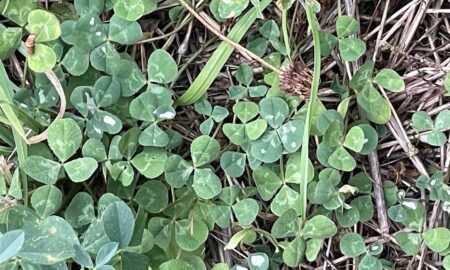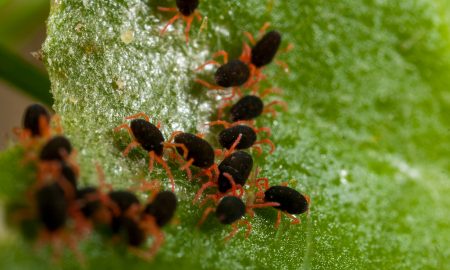The early break in many cropping areas of NSW and north-eastern Victoria have trigged the first sightings of pests as early-sown crops emerge. Other pests sit in waiting.
What’s been reported?
Lucerne flea has been reported feeding on emerging canola in a paddock west of Henty in the NSW Riverina. The seed was coated with a neonicotinoid insecticide, although this group of chemicals is not expected to be particularly effective against this pest.
University of Melbourne researcher Josh Douglas has also observed early signs of lucerne flea in the southern Riverina and northern areas of North East Victoria. However, Josh reports that population levels are much lower than in 2014.
It remains to be seen if this pest will achieve the same proportions as last year.
Josh has also recorded the first appearance of blue oat mite in this same region. Similarly, blue oat mites have been recorded on seedling pasture north of Henty in the NSW Riverina.
It pays to be prepared; check before sowing for…
Cockchafers
Yellowheaded cockchafer (Sericesthis harti) is the main species of white curl grub affecting cereal crops across south-eastern Australia.
Control with foliar insecticides is not possible as the larvae live exclusively in the soil, although insecticide seed treatments are now available for low to moderate populations.
Intensive crop rotations and short pasture rotations can also be used to prevent future damage.
False wireworms
There are a few groups of false wireworms found in Australia that are difficult to control after sowing.
Grey false (or small) wireworm (Isopteron spp.) larvae are brown or black and grow no longer than about 10 mm long with two prominent upturned spines on the end of the last segment. They are a pest of canola, in particular when germination is slowed by continued dry weather.
Eastern false wireworm (Pterohelaeus spp.) is an occasional pest of cereal crops in eastern Australia. They are similar to, although often larger than, other false wireworms. The larvae have cylindrical elongated bodies that range in colour from creamy-tan to yellow-orange.
Carabid beetle predators, trash removal techniques, insecticide furrow and seed treatments and use of press wheels at sowing may all reduce false wireworm populations.
Monitor crops after emergence for…
Lucerne flea (Sminthurus viridis)
This is a green-yellow globular insect commonly found in broadleaf crops and pastures. It feeds through a rasping process, which results in the characteristic appearance of feeding ‘windows’ through the leaf.
Lucerne fleas have a furcula underneath their abdomen that acts like a spring and enables them to ‘spring off’ vegetation when disturbed. If their damage warrants control, treat the infested area with an insecticide three weeks after lucerne fleas first emerge in autumn.
Synthetic pyrethroid sprays should be avoided. Grazing management, border sprays or spot spraying may be sufficient to control lucerne flea populations.
Blue oat mite (Penthaleus spp.)
Adult blue oat mite are approximately 1 mm in length and have a blue-black body with a distinctive red mark on their back.
There are three pest species of blue oat mites that differ in their distributions, pesticide tolerances and host plant preferences.
For low-moderate mite populations, insecticide seed dressings are an effective method. Avoid prophylactic sprays; apply insecticides only if control is warranted and if you are sure of the mite identity.
Balaustium mites (Balaustium medicagoense)
These are the largest of the pest mites commonly found in broadacre crops and are also slow moving.
This species has a high natural tolerance to many insecticides and will generally survive applications aimed at other mite pests, with Pyrinex Super being the only registered product.
Other strategies that are not reliant on chemicals, such as early control of summer weeds, should be considered.
Black Portuguese millipedes and slaters
Rises in black Portuguese millipede (Ommatoiulus moreletii) and slater populations in recent seasons are likely due to increased uptake of no-till practices and stubble retention.
Reduction of paddock stubble during summer may reduce numbers.
The presence of millipedes and slaters in crops does not necessarily mean damage will occur.
Preventative action is a key part to control as there are limited management options after crop-emergence.
Beetle pests
Bronzed field beetles (Adelium brevicorne) damage plants by chewing on seedlings at or above ground level. Like other false wireworm species, larvae have cylindrical elongated bodies and attack canola above the ground and at the base of plants.
Adult beetles are shiny black with a slight bronzed appearance.
Bronzed field beetle larvae may feed on roots and underground stems of plants. Damage is most severe where crop growth is slowed by dry or cool conditions.
We have received reports of weevils damaging established lucerne and tonic plantain, but the higher risk pests to establishing crops are Mandalotus weevils, particularly on the lighter calcareous soil types of the Mallee districts.
Adult Mandalotus weevils are flightless, approximately 3-5 mm long, round and dull brown in appearance.
Feeding damage appears as holes chewed in leaves, and in severe cases the seedlings are ‘ring barked’ just above ground level.
There are currently no insecticides registered against Mandalotus weevil in field crops; there are some reports that Mandalotus weevils are difficult to control and may have a higher tolerance to insecticides compared with other weevil species.
Acknowledgements
This information has been extracted from the PestNote series, a comprehensive compilation of pest information through a cesar-SARDI collaboration.
Sources of field reports
Josh Douglas – Researcher, The University of Melbourne
Dr Michael Nash – Researcher, SARDI (Adelaide)
Warwick Nightingale – Agronomist, Delta Ag (NSW Riverina)
Cover image: Photo by Andrew Weeks, Cesar Australia





